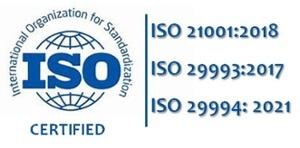In this post, we've gathered all the commonly asked questions about the ISO 45001 Standard together with expert answers.
Download the Free ISO 45001 Certification e-Book for answers.
Here, we at deGRANDSON Training, a provider of ISO 45001 training, have assembled a comprehensive set of ISO 45001, Occupational Health & Safety Management System, FAQS...
- What is ISO 45001?
- What is ISO?
- What is the purpose of ISO 45001?
- What does it mean to be certified to ISO 45001?
- Do You Need to be certified to ISO 45001?
- Who Issues ISO 45001 certificates?
- How to Get an ISO 45001 Certificate?
- Who needs an Occupational Health & Safety Management System (OHSMS)?
- What are the Benefits of a Formal OHSMS?
- What are Risk Assessments and Risk Treatment Plans about?
- Is an Emergency Evacuation Plan sufficient to meet Preparedness and Response requirements?
- Who needs to be certified to ISO 45001?
- How much does it cost to be certified to ISO 45001?
- How to Choose a Certification Body?
- How do you check if an organization is certified to ISO 45001?
- Are £375 ISO 45001 Certificates You Can Get Within 7 Days Legitimate?
- Why is it Important to Get Certified by the Proper Certification Body?
- How do you get certified to ISO 45001?
- Do OH&S Officers or others responsible for an OHSMS need training?
- Do Internal Auditors need training?
Click on the e-Book image to get your copy.
Do you have a question we still need to answer?
We'd love to hear it and, if possible, answer it for you. Just use our Support Ticket System. You'll find a Knowledge Base there that might have an immediate answer for you. Otherwise, fill in a Ticket.
For more, visit deGRANDSON Support Ticket.
Related Articles
- Workplace Safety Overview
- Free ISO 45001 Implementation Handbook (200+ pages)
- ISO 45001 Consultancy: How to be an OHSMS Consultant
- ISO 45001 Requires Risk Management & not Just Risk-based Thinking
deGRANDSON Global is an ISO Certified Educational Organization
We have chosen ISO 21001 certification because, unlike IRCA and Exemplar badges (which in our opinion are commercially compromised), it is based on independent third-party assessment. It is a ‘university grade’ standard in use globally by schools, colleges, and universities to demonstrate their competence.
Offices in Manchester. UK, Pembroke Pines, Florida, USA & Limassol, Cyprus (HQ).


